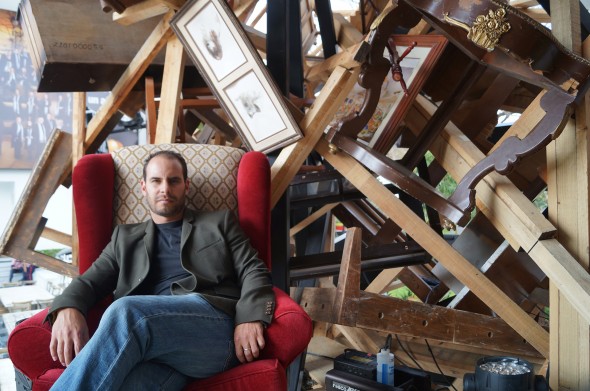
antonio o’connell + pepsi + liter of light. design week mexico 2015.
Mexico City hosts Design Week Mexico. One of the exhibitions is called ‘Light in the Darkness’- where Mexican artist Antonio O’Connell contemplates the idea of living without light. He has partnered with Pepsi and Liter of Light to bring “Ignite the Light” – a program that fuses art, philanthropy and social commentary and action.
Pepsi, through their Pepsi Challenge, a worldwide initiative bringing attention to communities that lack access to electricity and basic lighting solutions. Liter of Light, using empty recycled plastic bottles, innovative designs and simple circuitry, builds solar lights for day and night with zero carbon emissions.
“Light in the Darkness” is a a large scale, mixed media art installation that mirrors Liter of Light’s core work, the use of recycled plastic bottles to transform colors and lights in unexpected ways, illuminating an otherwise ordinary space and shedding light on the millions of people who live without it on a daily basis.
We talk to the artist.
[DesignApplause] Antonio, please tell us about the concept behind ‘Light in the Darkness’.
[Antonio O’Connell] We live in a world of great social contrasts where imagination is a luxury for some but a necessity for others. Many of us take for granted that we open a faucet and we have running water or turn a switch and have light. I thought of the idea of living without light and remembered a quote by Gaston Bachelard in his book “Poetics of Space”: “The house we were born in is more than an embodiment of home, it is also an embodiment of dreams”.
So “Light in the Darkness”” alludes to the ephemeral construction of “favelas” and shanty towns but with a vision of hope when light is provided to homes with Pepsi® PET bottles by the “Liter of Light” Foundation. Light transforms a dark place into a place of fantasy where new forms and colors are possible and the hope to dream farther.
[DA] What has this particular project taught you?
[AO] I wasn’t aware of the “Liter of Light” foundation and their simple but innovative way to bring light into communities that have none. By participating in this Pepsi® global initiative I was inspired by the wonderful job their doing and felt motivated to be a part of it.
[DA] You’re both an architect and an artist. Tell us what each discipline means to you and how they play off the other for you.
[AO] For me it’s hard to tell them apart because I see my work as it is. I guess it depends on the context you view the work it can be experimental Architecture or Installation Art. You can think its Art but then again isn’t Architecture a form of Art? I left my “conventional” architectural work since 2006 and began to focus on more conceptual and/or experimental work.
[DA] What’s the process of concept to the finished piece in your Architecture or Art? Do you use the computer or old school methods?
[AO] The concept is always embedded in the finished piece, even during the process, which is usually hand crafted from sketching to modeling to building. I don’t use computers because my work is very intuitive and hands on, besides it alludes to the self building in marginalized communities as well as the hand craft of the traditional construction workers in Mexico.

[DA] Who has inspired and influenced you in both Architecture and Art?
[[AO] Influence and inspiration comes from everywhere not just Architecture and Art, but to name a few, in Architecture it has been Enric Miralles which I had the chance to meet and study a small course, the Deconstructive movement as well as the Russian Constructivists, Vladimir Tatlin, Peter Eisenman, Archigram, Lebbeus Woods, Thom Mayne, Rem Koolhaas, Coop Himmelblau, Samuel Mockbee, Hundertwasser, Richard Rogers and Renzo Piano, the Mexican architects Luis Barragán and Juan O’Gorman. In Art there are many as well but usually artists trained as architects or their work related to Architecture: Gordon Matta-Clark, Kurt Schwitters, Situationist International, Bauhaus, Tadashi Kawamata, Ai Wei Wei, Richard Serra, Joseph Beuys, Francis Alÿs, González Gortázar, Mathias Goeritz, the Mexican Muralist Movement, Gabriel Orozco, to name a few.
[DA] Design Week Mexico goes back to 2009. Have you been involved with this event before? Can you tell us about the evolution over the past seven years and how the city and world responds to a design week?
[AO] This is the first time that I’ve been involved with Design Week Mexico. I don’t really know about the evolution of Design Week Mexico during these years, I just know it has grown a lot. People are more aware about design and interested to see what’s being done. This makes it a great opportunity to present this project with Pepsi® that blends design, art and architecture with a social cause benefit program.
[DA] What other architecture & design events have been able to attend?
[AO] I was invited to a work for Kartell Loves Mexico design event.
[DA] Anything else you wish to say that we haven’t talked about?
[AO] I am very happy to take part in such an important initiative like Pepsi Challenge and be able to support the efforts of “Liter of Light” to bring attention to important matters like access to basic services for those in need.



